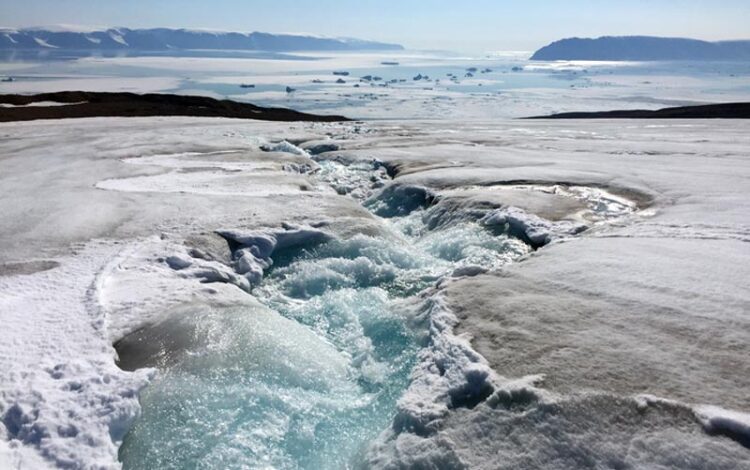Cheap and effective monitoring of glacier discharge

Qaanaaq Glacier, Greenland
Photo: Evgeny Podolskiy
Acoustic signals can be effectively used for monitoring glacial runoff and provide a cheaper and more accessible alternative to existing methods.
Glaciers have been melting and shrinking at an alarming rate, raising the sea-level and causing outburst floods. Scientists are monitoring this change to gauge the meltwater contribution to the ocean and freshwater resources across the globe while also keeping an eye on the risk of glacial flooding. However, glacio-hydrological monitoring is a luxury not every country can afford. The process requires either a substantial effort by observers or sophisticated technology with large volumes of data.
A team of scientists from Hokkaido University led by Evgeny A. Podolskiy, has proposed a safe, affordable, and effective approach for monitoring glacial discharge using sounds generated at the proglacial run-off site. The method, published in the journal Geophysical Research Letters, is not only ~100 times cheaper than the most novel methods but also non-invasive, quick and easily deployable, and can become a tool for long-term glacier monitoring.
Previous research, including that from the team, linked inaudible (infrasound) signals to glacial runoffs, noting a daily variation in the recordings and a peak during the summer. It was hypothesized that these signals might be generated by the radiation of air-pressure waves from the glacial runoff. Consequently, it was suggested that glacier discharge could be measured by analyzing the audible sounds that are also emitted by melting glaciers.
The team of researchers conducted the first near-source study at Qaanaaq Glacier, Greenland, that showed acoustic noise levels scale with proglacial discharge, with an easy-to-detect, audible diurnal pattern. “The ambient sound could be described as a continuous hum of roaring water, which would be familiar to anyone who walked near a white water,” said Podolskiy.
For recording the ambient soundscape, the team deployed a commercially available bird-song recorder near the terminus of the Qaanaaq Glacier. “We estimated the proglacial discharge by water-depth and flow-speed measurements, which were collected at the intersectional site of the proglacial stream and the road between Qaanaaq and the local airport. The acoustic data was analyzed and the result was then cross-correlated with the discharge in order to single out a frequency band that was the best proxy for the proglacial stream,” explains Podolskiy.
The highest correlation was seen in the frequency range of 50–375 Hz. The scientists also found that the noise level clearly mimicked the temporal variation in runoff. Moreover, they observed that the acoustic signal was recorded ~50 minutes before a corresponding change in discharge.
The study demonstrated that audible acoustic signals can be used for sensing glacio-hydrological variations remotely and continuously. The method reduces the risk of instrument loss and does not require avant-garde data processing techniques. Although it does not provide the high spatial resolution of fiber-optic tools that are currently used, it breaks new ground in terms of affordability and overall simplicity. This method can be used to set up early-warning systems to timely detect events like glacier lake outbursts and help mitigate glacial flooding events.
The team acknowledges that the sound-discharge relationships in glaciated watersheds may be complex. Future efforts might benefit from a long-term monitoring, clarified relationship between audible and inaudible sounds, as well as assessed interference effects of wind.
Journal: Geophysical Research Letters
DOI: 10.1029/2023GL103235
Method of Research: Data/statistical analysis
Subject of Research: Not applicable
Article Title: Acoustic Sensing of Glacial Discharge in Greenland
Article Publication Date: 26-Apr-2023
All latest news from the category: Earth Sciences
Earth Sciences (also referred to as Geosciences), which deals with basic issues surrounding our planet, plays a vital role in the area of energy and raw materials supply.
Earth Sciences comprises subjects such as geology, geography, geological informatics, paleontology, mineralogy, petrography, crystallography, geophysics, geodesy, glaciology, cartography, photogrammetry, meteorology and seismology, early-warning systems, earthquake research and polar research.
Newest articles

The future of digital agriculture
The Center for Digital Agriculture showcased the many advancements in digital agriculture during its annual conference. When the Center for Digital Agriculture (CDA) launched in 2018, they were looking forward…

Physicists arrange atoms in extremely close proximity
The technique opens possibilities for exploring exotic states of matter and building new quantum materials. Proximity is key for many quantum phenomena, as interactions between atoms are stronger when the…

For microscopic organisms, ocean currents act as ‘expressway’ to deeper depths
New research shows how tiny plant-like organisms hitch a ride on ocean currents to reach darker and deeper depths, where they impact carbon cycling and microbial dynamics in the subtropical…





















